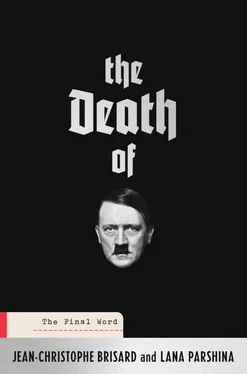And a report? Some data, an analysis, anything…? “Nein!” A “nein” not much different from the “niets” that we received so often in Moscow.
No capsules in Germany, nothing in Russia and nothing in France. Which left the British and the Americans.
A video dated 4 June 1945 gave us hope. This was a British news story soberly titled “The Last of Europe’s Butchers.” The “butcher” in question was none other than Himmler. In these pictures, you can see the house where he is supposed to have committed suicide, as well as his corpse. But most importantly it shows a cyanide capsule. The quivering, nasal voice of the journalist of the time explains that this is a capsule identical to the one used by Himmler. By freezing the image we can tell without risk of error that the cyanide is in the form of a colourless liquid, not powder. Only one of the ends of the capsule, thinner than the other, presents an opaque and coloured appearance.
In all likelihood, the cyanide used by Himmler must have been hydrogen cyanide, better known as Prussic acid. Prussic, because it was discovered in the late eighteenth century by a Swedish chemist, Carl Wilhelm Scheele, on the basis of Prussian blue. Furthermore, in German, Prussic acid is called Blausäure , or “blue acid.” This form of cyanide is probably the most dangerous of the lot. Fatal from a dose of 50 milligrams. Hitler and his wife very probably received the same type of cyanide.
It remains to be seen if the dictator used this poison to kill himself.
Günsche didn’t think so!
He swore as much in a court in his country, in Germany. That was in 1945. The former SS man had just been freed from the Soviet camps after ten years of detention. He came back on 28 April 1956. He then discovered that Germany had been divided into two states in 1949. In the west, the three occupied zones under American, British, and French control formed the BRD (the Federal Republic of Germany). He learned, most importantly, that after being sentenced (in 1950) and condemned to twenty-five years in prison by a Soviet court (he would be freed six years later after an intervention by Konrad Adenauer, the Chancellor of the BRD), he also had some questions to answer in a German court. Not on his own behalf, but to bring a legal end to Hitler’s fate. Ten years after the fall of the Nazi regime, it was time to rule once and for all on the death of the dictator. Günsche was not the only person close to Hitler to return to German soil. In 1944, Adenauer negotiated with the Soviets for the repatriation of the last German prisoners, those convicted of war crimes. Among them we find the three major witnesses of the last hours of Hitler, Günsche as well as Linge and Baur. Günsche and Linge’s statements were recorded by the court in Berchtesgaden. They were made separately and over several days between 10 February and 19 June 1956.
Until 2010, these audio tapes slumbered on shelves in the State Archives in Munich. For technical reasons it was impossible to play them. Carefully restored, they are now accessible once again. In the recordings, the two men testify before a judge and representatives of the Bavarian police, including the head of the criminology service and an expert doctor. Once again, Linge and Günsche were interrogated about the last moments of Hitler in his bunker on 30 April 1945. The two men were exhausted by years of detention in Soviet jails, and particularly by the unstinting interrogation sessions conducted by the Russian secret services. For ten long years they were asked to repeat the same facts over and over again. Could they even remember with any precision what really happened on 30 April 1945? Had their memories not been erased by being repeatedly summoned and called into question?
Before judges in their country, the two men replied again, almost mechanically. Günsche declared: “As I have already said, I carried the body of Eva Braun–which was not covered–in my arms, and I noticed an extraordinarily strong smell of almonds. I did not notice that smell on Hitler. Particularly when his corpse was set down on the ground in the garden. When Bormann pulled away the blanket [covering Hitler], I brought myself quite close to it, and noticed nothing of the sort.” [64] Audio archives of the interrogation of Otto Günsche, 1956, Munich State Archives (Staatsarchiv München), CD/DVD 71 à 74.
Was the Führer’s former aide-de-camp telling the truth? Unlike the Soviets, who stressed the theory of suicide by poisoning, an act which they thought was tainted with cowardice, did Günsche not want to present his boss as a man capable of killing himself with a bullet to the head? With all the warlike symbolism attached to the gesture in his eyes? The witness statement that Günsche gave to the German court, while rich in details, partially contradicts the one given by Linge. And it does so on certain important points. This is what Günsche has to say about discovering the corpse of Hitler and his wife in their antechamber:
Bormann and Linge prepared to enter Hitler’s office. I followed them, and the following image presented itself to me: Hitler was sitting in an armchair, almost facing the door, with his gaze directed towards the door to the left, his head leaning towards the right shoulder which rested against the arm of the chair, his hand dangling. […] Eva Braun was lying on the sofa facing the door at the end of the room, her head turned towards Hitler, lying on her back, her legs slightly bent and drawn up towards the body; the shoes–light women’s shoes–were on the sofa. [65] Ibid.
The German investigators took note, but were surprised. They wanted details. Günsche obliged:
Hitler was sitting—I would say slightly sagging, but that wasn’t very remarkable—on the armchair, leaning slightly towards the right, his right hand dangling over the right arm, his head leaning slightly to the right over his right shoulder. As far as I remember, his mouth was slightly open, his chin slightly slack, but I can’t confirm that…
So Hitler had killed himself in an armchair and not on a sofa with Eva Braun. The aide-de-camp’s version contradicted the one that Linge gave the German investigators:
When I entered the room, Hitler was sitting on the left–seen from my point of view–Hitler on the left, more precisely in the left corner of the sofa.
Investigator:So on the left from your point of view, on the right-hand side of the sofa?
Linge:Yes, right in the corner. [66] Ibid.
Who is telling the truth? Is it possible to make a mistake like that? If we keep to the arrangement of the furniture in the room where the two suicides took place, the answer is no! The German investigators returned repeatedly to the arrangement of the room. And they asked Linge to confirm it.
Investigator:The room had a surface of about 8m 2, it was more or less square, it had a door that opened from the central corridor, we may imagine that the corridor also served as a meeting place for the people from the entourage when waiting, you could also sleep there, there was a sofa.
Linge:Only on the last day…
Investigator:[…] The room had two other exits, on the right towards Adolf Hitler’s bedroom, and on the left towards the bathroom. In terms of furniture, there was a sofa that was about 2 metres long, a normal sofa with arms. In front of that sofa, a table, not very large…
Linge:A small table…
Investigator:On either side of that table, you mentioned the presence of an armchair on each side. The sofa was against the wall facing the door, there was a table in front of it, and again to the right of this entrance a large desk with a chair in front of it. Herr Linge said that it was so cramped that one could barely pass between the table and the desk when there were chairs in the room. Then the painting of Frederick the Great–which is not of any great importance for us–above the desk, a painting that Hitler was particularly fond of.
Читать дальше












